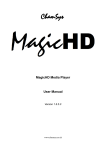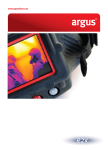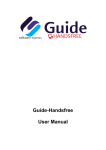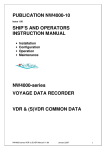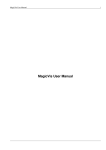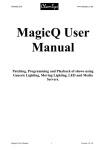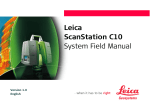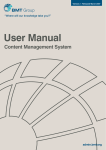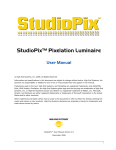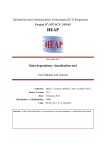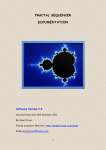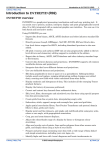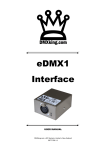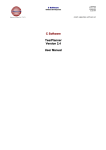Download MagicHD Media Player User Manual
Transcript
ChamSys MagicHD Media Player User Manual Version 1.6.0.6 www.chamsys.co.uk ChamSys MagicHD User Manual Version 1.6.0.6 About this Manual This manual is designed for operators of the MagicHD media player to help them quickly and effectively learn how to use the software. The reader is assumed to have a basic familiarity with the concepts of media players and lighting control systems. Since MagicHD is designed to be controlled by the MagicQ range of lighting consoles, the reader should also be familiar with MagicQ. Readers who are tight for time and just want to find out how to quickly program a working show should turn straight to the Getting Started section on page 8. ChamSys Ltd The features and functions of the MagicHD media player and the ideas contained therein are the property of ChamSys Ltd. The media player is intended for the control and display of moving and static images. No warranties are expressed or implied regarding the use of the MagicHD media player. No liabilities are accepted for the accuracy of the information contained within this manual. The MagicHD media player product is supplied and designed by ChamSys Ltd. Products containing ChamSys Ltd software and firmware embody proprietary information and are licensed not sold and may not be duplicated in any way. ChamSys Ltd does not guarantee the accuracy, adequacy, suitability or completeness of any information or products and is not responsible for any errors or omissions or the results obtained from use of such information or products. ChamSys Ltd does not accept responsibility for the consequences of misuse or abuse of its software. None of the equipment or software supplied by ChamSys Ltd may be used in any life-critical or potentially life-endangering situations or in situations where personal injury may result. ChamSys Ltd reserves the right to make any changes and/or improvements or to discontinue any and all of their products or services without prior notice, and advises customers to obtain the latest version of relevant information to verify, before placing orders, that information being relied on is current and complete. All products are sold subject to the terms and conditions of sale supplied at the time of order acknowledgement, including those pertaining to warranty, patent infringement, and limitation of liability. Some of the available functions of products may be altered over the life of the product. All other product names are trademarks or registered trademarks of their respective owners. No part of this publication may be reproduced or distributed, transmitted, transcribed, stored in a retrieval system, or translated into any language in any form by any means without the prior written permission of ChamSys Ltd. Copyright 2013 by ChamSys Ltd. All rights reserved. www.chamsys.co.uk Page 2 of 42 ChamSys MagicHD User Manual Version 1.6.0.6 Table of Contents 1 Introduction......................................................................................................................................6 1.1 Disclaimer.................................................................................................................................6 1.2 Known Problems.......................................................................................................................7 1.3 References.................................................................................................................................7 2 Getting Started..................................................................................................................................8 2.1 Super Quick Start......................................................................................................................8 2.2 Quick Start................................................................................................................................8 2.3 Adding a Mask..........................................................................................................................9 2.4 HUD..........................................................................................................................................9 2.5 Keystone...................................................................................................................................9 2.6 Projector Colour Control..........................................................................................................9 2.7 Displaying Text.........................................................................................................................9 2.8 MagicHD Window..................................................................................................................10 2.9 Adding Media.........................................................................................................................10 2.10 Converting Existing Media...................................................................................................11 3 Media..............................................................................................................................................12 3.1 Adding Media.........................................................................................................................12 3.1.1 Automatic Conversion.....................................................................................................12 3.1.2 Deployment.....................................................................................................................14 3.1.3 Notes...............................................................................................................................14 3.2 Masks......................................................................................................................................15 3.2.1 Examples.........................................................................................................................15 3.2.2 Mirroring and Inverting..................................................................................................16 3.2.3 Notes...............................................................................................................................17 4 Media Layers..................................................................................................................................18 4.1 Intensity..................................................................................................................................18 4.2 Position...................................................................................................................................18 4.3 Scale........................................................................................................................................18 4.4 Rotation...................................................................................................................................18 4.5 Mirror/Flip..............................................................................................................................18 4.6 Stretch.....................................................................................................................................18 4.7 R/G/B......................................................................................................................................19 4.8 Colour Effect...........................................................................................................................19 4.9 Blend.......................................................................................................................................19 4.10 Folder and File......................................................................................................................20 4.11 Start and End Frame..............................................................................................................20 4.12 Speed.....................................................................................................................................20 4.13 Play Mode.............................................................................................................................20 4.13.1 Once..............................................................................................................................21 4.13.2 Once-then-black............................................................................................................21 4.13.3 Loop..............................................................................................................................21 4.13.4 Bounce..........................................................................................................................21 4.13.5 First frame.....................................................................................................................21 4.13.6 Last frame.....................................................................................................................21 4.13.7 Pause.............................................................................................................................21 4.13.8 Next frame.....................................................................................................................21 4.14 Transition..............................................................................................................................22 Page 3 of 42 ChamSys MagicHD User Manual Version 1.6.0.6 4.15 Mask Opacity........................................................................................................................22 4.16 Mask Folder and File............................................................................................................22 4.17 Mask Invert...........................................................................................................................22 4.18 Mask Mirror/Flip..................................................................................................................22 4.19 Mask Stretch.........................................................................................................................22 5 Text Layer.......................................................................................................................................23 5.1 Intensity..................................................................................................................................23 5.2 Position...................................................................................................................................23 5.3 Scale........................................................................................................................................23 5.4 Rotation...................................................................................................................................24 5.5 R/G/B......................................................................................................................................24 5.6 Background R/G/B.................................................................................................................24 5.7 Background Transparency......................................................................................................25 5.8 Text Folder and File................................................................................................................25 5.9 Font.........................................................................................................................................25 5.10 Text Lines..............................................................................................................................25 5.11 Scroll Direction.....................................................................................................................25 5.12 Scroll Speed..........................................................................................................................25 5.13 Loop......................................................................................................................................26 5.14 Pause 1..................................................................................................................................26 5.15 Pause 2..................................................................................................................................26 5.16 Scroll Char............................................................................................................................26 5.17 Scroll Line.............................................................................................................................26 5.18 Scroll Time............................................................................................................................26 6 Output Layer...................................................................................................................................27 6.1 Intensity..................................................................................................................................27 6.2 Position...................................................................................................................................27 6.3 Scale........................................................................................................................................27 6.4 Rotation...................................................................................................................................27 6.5 Mirror/Flip..............................................................................................................................27 6.6 R/G/B......................................................................................................................................27 6.7 Colour Effect...........................................................................................................................27 6.8 Mask Folder and File, Invert, Mirror/Flip..............................................................................28 6.9 Keystone.................................................................................................................................28 6.10 HUD Control.........................................................................................................................28 7 Head Up Display............................................................................................................................29 7.1 HUD Anatomy........................................................................................................................30 8 MagicHD Window..........................................................................................................................31 8.1 Full Screen Mode....................................................................................................................31 8.2 Status.......................................................................................................................................31 9 DMX Personality............................................................................................................................32 9.1 Universe..................................................................................................................................32 9.2 Output Layer...........................................................................................................................33 9.3 Text Layer...............................................................................................................................34 9.4 Media Layers..........................................................................................................................35 9.5 Parameter Types......................................................................................................................36 9.5.1 Angle...............................................................................................................................36 9.5.2 Blend Type......................................................................................................................36 Page 4 of 42 ChamSys MagicHD User Manual Version 1.6.0.6 9.5.3 Colour Effect...................................................................................................................36 9.5.4 Colour Scale....................................................................................................................36 9.5.5 Direction..........................................................................................................................37 9.5.6 Duration..........................................................................................................................37 9.5.7 Flag..................................................................................................................................37 9.5.8 HUD Control Bitmask....................................................................................................37 9.5.9 Keystone..........................................................................................................................37 9.5.10 Layer Stretch Mode.......................................................................................................38 9.5.11 Mirror / Flip...................................................................................................................38 9.5.12 Number..........................................................................................................................38 9.5.13 Play Mode.....................................................................................................................39 9.5.14 Scale..............................................................................................................................39 9.5.15 Screen Offset.................................................................................................................39 9.5.16 Speed Factor..................................................................................................................39 9.5.17 Text Loop Mode............................................................................................................40 9.5.18 Transition Type..............................................................................................................40 10 Background Information..............................................................................................................41 10.1 Video Clips............................................................................................................................41 10.2 Files and Folders...................................................................................................................41 Page 5 of 42 ChamSys MagicHD User Manual Version 1.6.0.6 1 Introduction MagicHD is a DMX controlled media player. Media playback is managed in layers. MagicHD can display up to 8 media layers (depending on product), one text layer and a final output layer for overall control of the output. MagicHD runs on Windows, Mac and Linux, and can exist as a stand-alone player, or be launched from MagicQ PC. It can be installed on dedicated hardware, either supplied by the user, or purchased from ChamSys. See [1]. Each media layer can display one media file (movie or picture) and optionally apply a mask. Layers are stacked from 1 (the bottom) to 8 (the top). Subject to masking and blending, higher layers will hide lower layers. The output layer can also apply a mask, with the intention that this is used for shuttering, edge blending and similar projector control effects. You can of course use the masks for anything you wish. The text layer can display static or moving text. The text is displayed in a window whose colour, position and orientation can be controlled. Content is supplied as raw text files. Both the media and output layers can apply a number of basic colour effects. Effects applied in the output layer affect the appearance of the whole output. Conceptually, the output seen by the viewer is the top of a stack of layers: Top Colour control Final mask Text Media N ... Media 3 Media 2 Bottom Media 1 MagicHD has no user interface as such, being entirely controlled by DMX. It does provide a Head Up Display (HUD) which shows a lot of useful information, live, superimposed on the output. The DMX control personality is deliberately simple: complexity is added by the lighting console. Since everything is controlled by DMX channels, the console can be used to add effects to any channel by simply altering the values sent to the player. 1.1 Disclaimer This product is not fully released so the DMX personalities used to control it may change without notice. If such a change occurs then show files using MagicHD will have to be manually updated. Changes will be highlighted in this manual. Page 6 of 42 ChamSys MagicHD User Manual Version 1.6.0.6 1.2 Known Problems Known major problems with MagicHD: • • • • • • • Playback of multiple layers of some HD media content types can be jerky or slow the system down: load management is not yet implemented (whereby lower layers will skip frames to ensure the correct frame rate is maintained). Text layer is rendered at a fixed point size so text is blocky when a small number of lines fills the screen. Aspect ratio appears to change when objects are rotated. Playback is not properly synchronised between layers. Playback can freeze if you change start or end frames whilst a movie is playing. This is not permanent: if you change the media to another file, then back, the playback is correct. When intensity is zero the media is still decoded, wasting processing power. With Windows 8 MagicHD must be run as administrator for media conversion to work. 1.3 References [1] [2] [3] http://www.chamsys.co.uk/magichd http://en.wikipedia.org/wiki/Video_compression_picture_types http://en.wikipedia.org/wiki/H.264/MPEG-4_AVC Page 7 of 42 ChamSys MagicHD User Manual Version 1.6.0.6 2 Getting Started The following instructions assume you are using MagicHD as part of MagicQ PC. Most steps are the same for other system configurations. 2.1 Super Quick Start setup → NEW SHOW patch → CHOOSE DIM/MEDIA → MagicHD → PATCH IT In the patch keypad, type '1' and ENTER, then NO. setup → VIEW SYSTEM → VIEW MEDIA From the application menu: Media Player → View Media Output Media Player → Select Server, close. Select the MagicHD window, position it in the required screen and press F11 media → Output → LOCATE → Layer 1 → LOCATE 2.2 Quick Start setup → NEW SHOW patch → CHOOSE DIM/MEDIA → MagicHD → PATCH IT In the patch keypad, type '1' and ENTER, then NO. MagicHD takes one whole DMX universe so there are no alternative configurations. patch → VIEW DMX to confirm. setup → VIEW SYSTEM → VIEW MEDIA should show server 1 being a MagicHD with Local as the IP address. This means it will be accessed directly, not over the network. Edit the name if you wish: double click the name, or select the cell then press set twice. Enable live previews for the server: double click on the Live prev cell and select YES, or select the cell and type 1, ENTER. From the application menu: Media Player → View Media Output to start MagicHD. A blank window should appear. This can be moved around your screen(s) and maximised (without a border) by pressing F11 . Media Player → Select Server allows you to choose the ID for the local MagicHD window. media will show the media window. The MagicHD that you just patched should appear as a button, along with buttons to select the media, text and output layers. If you have media, thumbnails should appear below the layer buttons: Page 8 of 42 ChamSys MagicHD User Manual Version 1.6.0.6 Output → LOCATE → Layer 1 → LOCATE will display the media from Media Folder 1/Media File 1 at full intensity. 2.3 Adding a Mask media → MagicHD → Layer 1 → Mask then use Mask Folder and Mask File to select a mask. Thumbnails should be displayed for each folder: simply select the mask by clicking a thumbnail. 2.4 HUD media → MagicHD → Output → Media will allow encoder wheel A to select the HUD. Alternatively press and hold “HUD Control” for buttons for each option, or click the top and bottom of “HUD Control” to cycle through the options. 2.5 Keystone media → MagicHD → Output → Frame 2.6 Projector Colour Control media → MagicHD → Output → Col Red, Green and Blue encoders control the colour balance of the output. 2.7 Displaying Text media → MagicHD → Text → LOCATE Use Text Folder / Text File to select your text file. At this point you should see your text. Use Pos to size and position the text layer (default is full screen) Use Media → No Of Lines to control how much text is shown in the window Use Media → Scroll Dir to control how the text scrolls if it doesn't fit into the window. Page 9 of 42 ChamSys MagicHD User Manual Version 1.6.0.6 2.8 MagicHD Window MagicHD is launched from within MagicQ PC from the “Media Player” menu. It can also be closed from here, or by closing its window. The MagicHD window can be positioned and sized just like any other application window. To go full screen with no borders (i.e. ready for output to a projector), select the window and press F11 , or select “Full Screen” from the Media Player menu. MagicQ will remember the position and size of the window for when you next open it. 2.9 Adding Media Chose a folder number that is either not in use, or will not clash with existing content. e.g. 13. Chose file numbers that will not clash with existing content (unless you want to overwrite). e.g. 1518. Create a numbered folder away from MagicQ PC/convert. e.g. temp └─ 013 Place your files in this folder. e.g. temp └─ 013 ├─ apple.mov ├─ banana.avi └─ orange.mp4 Add your chosen file numbers to the filenames. e.g. temp └─ 013 ├─ 015_apple.mov ├─ 016_banana.avi └─ 017_orange.mp4 Copy the finished folder(s) to MagicQ PC/convert …/MagicQ PC └─ convert └─ 013 ├─ 015_apple.mov ├─ 016_banana.avi └─ 017_orange.mp4 Wait for conversion to take place. Progress is reported on the HUD, and in the input display window (bottom right) in MagicQ PC. You can prepare media under MagicQ PC/convert, but every time you edit a file it will trigger the conversion process, resulting in errors if the filenames aren't in the correct format. Page 10 of 42 ChamSys 2.10 MagicHD User Manual Version 1.6.0.6 Converting Existing Media From the application menu: Media Player → Convert Media Once MagicHD is running, the Convert Media action allows you to force it to convert old content. This means you can prepare media when MagicHD is not running. This is worth while if you are preparing a lot of content: if MagicHD is running it will keep trying to convert files as you edit their names and move them around (unless you prepare the files elsewhere). Note: everything under MagicQ PC/convert will be converted, regardless of file age or previous conversion status. Page 11 of 42 ChamSys MagicHD User Manual Version 1.6.0.6 3 Media Media refers to movies, images, and text files. MagicHD can display all common image formats, and play almost any format of movie, although a number of restrictions apply. If you want to do anything other than play the entire movie forwards at normal speed the movie must only contain Iframes [2]. This is because playing backwards, skipping frames, or randomly accessing points within the clip requires that any frame can be displayed by itself. Performance will also be affected by file size, so consideration must be given to the quality (i.e. degree of compression) of the movies. Media is always addressed by a pair of DMX channels: folder and file. Wherever a media file can be selected, you will find the folder/file parameters. If MagicHD can't make sense of the selected file, in the context, it will be ignored. For example a movie could be selected as a mask, but it will not have any effect because it is not an image. When selecting media, if either the folder or file is zero, the effect is 'no selection'. 3.1 Adding Media MagicHD is supplied with a library of basic content to get you started, but most users will want to add their own content. Folders 1 to 9 are reserved for ChamSys libraries, and you are free to use folders 10 to 255 in any way you like. Folder and file numbers do not have to be sequential. Internally MagicHD stores media in numbered folders. Within each folder the file names start with a number. The folder and file number are the DMX folder/file parameters used to select that file. An index file is used to tell MagicHD which files to use (see section 10.2). For MagicHD to be able to use a new file it must be named correctly, placed in the right folder, and added to the index. To simplify this process, it is automated: 3.1.1 Automatic Conversion MagicHD monitors a folder called convert. When media files are added to that folder they are automatically converted (if required) then moved to the show's media folders. Once converted, the files are added to MagicHD's media index and can be used right away (without restarting). Files must be placed in a subfolder, under convert, whose name starts with a number (nnn, below). This number is taken to be the folder number of the resulting media file. The rest of the folder name is optional and is ignored by MagicHD. The file's name must start with a number (fff, below) then an underscore. This number is taken to be the media's number within its folder. The rest of the filename, after the underscore, is not processed, but copied verbatim. User folders start from 10 and file numbers start from 1: .../MagicQ PC └─ convert ├── nnn_folder_name : └─ fff_file_name.mov Page 12 of 42 ChamSys MagicHD User Manual Version 1.6.0.6 Monitoring for new files, and converting them, are background activities and do not impact playback. MagicHD only looks for changes to files, or the addition of files or folders. Any files already in place when MagicHD starts will be ignored. To trigger conversion of existing files just edit the file or folder name: adding or removing a leading zero is sufficient. Within MagicQ PC, the menu item Media Player → Convert Media can be used to force MagicHD to re-convert everything in the convert folder. This can be useful if new media has been prepared in situ before starting MagicHD. The criteria for triggering conversion (rather than just copying the media) are: Movie content Non I-frames Audio Action Converted to .mp4 (H.264 video [3]) with all I-frames. Note that this process decompresses the video, usually resulting in a much larger file than the original. Copied with audio stream(s) removed. Pictures and text files are copied unchanged, as are any movies that are already all I-frames and no audio. If you wish to exercise full control over the quality and format of your content, prepare it offline before placing it in the conversion area. If the content meets the basic criteria of all I-frames and no audio, it will not be converted, thus preserving the original quality and format. This diagram illustrates the relationship between the convert folder and the resulting media: User files Resulting media .../MagicQ PC .../MagicQ PC │ └─ show └─ convert └─ media ├─ 10myclips ├─ 010 │ ├ 1_sky.avi │ ├ │ ├ 2_planets.mp4 │ ├ │ └ 3_concert.mov │ └ ├─ 011_masks ├─ 011 │ ├ 10_mask1.bmp │ ├ │ ├ 30_mask2.jpg(2) │ │ │ ├ 30_mask2a.jpg │ ├ │ └ 40_mask3.png │ └ └─ 99text └─ 099 ├ 001_banner.txt ├ ├ 2_story.txt ├ └ 9_orion_lyrics.txt └ 001_sky.avi 002_planets.mp4 003_concert.mp4(1) 010_mask1.bmp 030_mask2a.jpg 040_mask3.png 001_banner.txt 002_story.txt 009_orion_lyrics.txt Note: (1) 3_concert.mov was converted to .mp4 because it was compressed video. (2) 30_mask2.jpg was overwritten by 30_mask2a.jpg because both files had the same media number. None of the following files would be converted, for the reasons given: Page 13 of 42 ChamSys MagicHD User Manual .../Magic PC ├─ convert_files │ └─ 1_one.avi └─ convert ├─ 2_two.mp4 ├─ clips │ └ 3_three.avi ├─ 1_folder_one │ └ 4_four.png ├─ 10_new_media │ ├ five.txt │ ├ 0_six.txt │ ├ 7_seven.doc │ └ 300_seven.txt └─ 20_more_movies ├ E_eight.mp4 └ 9nine.mp4 3.1.2 Version 1.6.0.6 wrong root folder not under a numbered folder folder has no number only folder numbers 10 to 255 are allowed file has no number only file numbers 1 to 255 are valid only .txt files are allowed for text only file numbers 1 to 255 are valid 'E' is not a number number not separated by an underscore Deployment To simplify deploying the media for a show, and deploying media from one player to another, MagicHD performs some automatic housekeeping processes in the background. Note that this means it is possible to manage your media content directly in the show folder by editing the folder and file numbering. When finished, simply delete the index file and thumbnail folder, then start MagicHD. 3.1.2.1 Index Regeneration If the media index file is missing MagicHD will automatically regenerate it from the media files in the show. Note that all media will be included in the index. There is no way to mark a file as not part of the show, other than obscuring its folder and/or file number. 3.1.2.2 Thumbnail Regeneration Each media file has a small thumbnail image associated with it. These thumbnails are used by MagicQ to display the contents of each media folder in the media window. If any thumbnail file is found to be missing, or older than the corresponding media file, it will be automatically regenerated. 3.1.3 Notes Please note the following points: Monitoring and conversion take place in the background so that they do not impact media playback. This means it is possible to add media during a show, but it is not recommended. MagicHD only checks for new files, out of date index, and missing thumbnails, periodically so the conversion process will not start the instant a new file is added. The conversion process can last a significant time if large movies are involved. You can monitor progress by bringing up the HUD (see 6.10, 7.1 and 8.2). The conversion process is: 1) new files are converted, Page 14 of 42 ChamSys MagicHD User Manual Version 1.6.0.6 2) the index is updated, 3) out of date thumbnails are regenerated While media is being converted, the thumbnails displayed in MagicQ's media window will be out of date. Once the thumbnails are ready the combined version (i.e. where MagicHD is local to MagicQ) will show new thumbnails as soon as you change folder in the media window. For remote servers, press the RELOAD THUMBS button (or shift for RELOAD ALL THUMBS): Until the index has been rebuilt, MagicHD will not be able to display new media. If the contents of an existing file changes, MagicHD will not automatically reload it. To force a reload, select a different file, then the original one. Feedback on progress is displayed on the status line of the HUD, and recorded in the conversion log file. 3.2 Masks A mask is simply an image whose intensity is used to control the brightness of some media behind it. White areas are totally opaque and black totally transparent. Shades of grey scale between the two. The simplest masks have just black and white areas, and hide the layer (allowing lower layers to be seen) where they are black. Any image can be used as a mask. Colour is converted to transparency by taking the black & white intensity of the image. If a mask is used in a layer its position is automatically synchronised with the media for that layer. As the layer is scaled, positioned or rotated, the mask is too. This greatly simplifies the use of masks. 3.2.1 Examples If we look at one frame of video and a simple black & white arrow as a mask, the results are as follows: = × If we have a more complicated grey scale mask, the effect is as follows: Page 15 of 42 ChamSys MagicHD User Manual Version 1.6.0.6 = × And if we use a coloured mask, this is the result: = × The examples above have the mask intensity set to full. Reducing the mask's intensity reduces its effect. Here is a mask at 0.33 intensity: ×0.33 = × 3.2.2 Mirroring and Inverting One image can produce a number of different masks depending on its mirror/flip and invert parameters: Normal Mirrored Flipped Mirrored & flipped Normal Inverted If the same mask is used on two layers, inverted in one, the layers can be blended together as follows: Page 16 of 42 ChamSys MagicHD User Manual Version 1.6.0.6 Layer 1 × = Layer 2 × = Output Layer Note that it is not actually necessary to use the mask on layer 1, since layer 2 overlays it anyway. The effect of the mask in layer 1 is that as layer 2 is faded out, layer 1 retains the black masked out area. 3.2.3 Notes Whatever the aspect ratio of an image used as a mask, its “screen” is the extent of the media for that layer. If the mask is stretched to Fill X & Y it will fill the area occupied by the media, not necessarily the whole screen. This can be overridden by the mask stretch parameter for the layer. For best results create your masks at the same resolution as your media, and use anti-aliasing to minimise visible pixellation around curves etc. Page 17 of 42 ChamSys MagicHD User Manual Version 1.6.0.6 4 Media Layers Each media layer can display either a movie or a static image. A mask can be used to control which parts of the layer are visible. The DMX parameters for the layer allow you to control the following features. For details of the Media Layer personality, refer to section 9.4. For details of the DMX parameters, refer to section 9.5. 4.1 Intensity Intensity is used to fade the layer into, or out of, the output. As a layer's intensity reduces, lower layers will show through. 4.2 Position Position controls where the centre of the layer appears in the output. 4.3 Scale Scale magnifies or reduces the size of the layer in the output. Note that when magnified, low resolution content can look poor. 4.4 Rotation Rotation allows a layer to be rotated around its centre point. 4.5 Mirror/Flip Mirror and flip allow the layer to be reflected horizontally (mirror) or vertically (flip), or both. 4.6 Stretch Stretch controls how the layer fills the screen. Every media file has an associated aspect ratio and this might not match the aspect ratio of the screen or projector. Stretch controls how the two aspect ratios are reconciled: Mode Screen Media Result Note Fill X Media aspect ratio maintained Fill X Media aspect ratio maintained. Overflows Y Page 18 of 42 ChamSys Mode MagicHD User Manual Screen Media Version 1.6.0.6 Result Note Fill Y Media aspect ratio maintained. Overflows X Fill Y Media aspect ratio maintained. Fill X & Y Media stretched in Y. Aspect ratio lost Fill X & Y Media stretched in X. Aspect ratio lost 4.7 R/G/B The R, G and B parameters allow the colour balance of the layer to be altered directly. 4.8 Colour Effect Colour effect, along with the associated R, G and B effect parameters, allows you to alter the colour of the layer in a number of ways. For details refer to the DMX parameter in section 9.5.3. A large number of effects are possible, and the best way to understand the parameters is to experiment. Here are some examples: Colour Effect FX R FX G FX B Result B&W Colourise 255 130 40 Sepia B&W Colourise 0 255 0 Black & Green (“night vision”) RGB Select 3 2 1 RGB → BGR colour swap RGB Select 5 6 7 Inverted colour RGB Select 8 8 8 Inverted black and white RGB Select 0 2 0 Green only (similar to Black & Green) RGB Select 0 4 0 Black & Green 4.9 Blend Blend controls how each layer is blended with the one below, in terms of colour and intensity. Blending takes place from the lowest layer upwards: Layer 2 blends with Layer 1, then Layer 3 blends with the result of 1 and 2, and so on. Page 19 of 42 ChamSys MagicHD User Manual Version 1.6.0.6 Normally layers are simply blended by brightness and transparency: when a layer is completely opaque (full intensity, no mask), nothing can be seen through it. Normally, as a layer is faded, it becomes transparent so things below it start to show through. If a mask is applied, dark areas of the mask make the layer transparent, allowing layers beneath to show through. Note that blend is only partially implemented. 4.10 Folder and File These allow the media for the layer to be selected. If either are zero, the layer is switched off. 4.11 Start and End Frame Start and end frame allow frame-wise control of which part of a movie is played. The default values are a start frame of zero and an end frame of 223 which mean the whole file is to be used. If the end frame is less than the length of the clip, playback will stop (or loop) when the end frame is reached. Similarly playback can be started at any point in the file by setting the start frame. To set the start and end frame accurately, use the First Frame or Last Frame play mode whilst changing the start or end frame values respectively. Turning on the HUD for the layer being programmed will also help since the start and end frame markers are shown on the media bar (see section 7.1. To take complete control of playback speed (e.g. to bounce a clip between two points in time to a beat), use “First Frame” play mode, then apply a ramp effect to the start frame channel. Note: • Although any values can be set in the DMX channels, the actual start frame will never exceed the end frame, nor will the end frame ever be earlier than the start frame. • If you are using start and end frame to permanently edit a clip (i.e. you don't change them or use a different part of the file in another cue), consider editing off-line since (a) the resulting file will be smaller and (b) using dedicated video editing software can produce better results. • The values in the DMX channels refer directly to the frame numbers within the media. Frame numbers run continuously from 0 to the end of the file. • The time that a frame number equates to depends on the frame rate of the file. 4.12 Speed Use the speed parameter to control the speed and direction of media playback. Negative speeds cause playback in reverse. A speed of 0 stops playback (although see 4.13.7). Up to 2 times normal speed, every frame is played. Bear in mind, therefore, that playing an HD clip x1.9 faster will nearly double the processing load for that layer. Above x2, frames are dropped to reduce the processing load. There is still an increased load for all but whole number multipliers: at x4.7, 3 out of every 4 frames are dropped, so the remaining load is x1.7. Since there is an inherent loss of quality at high playback speeds (because the human brain can't process the imagery so well), consider the quality and resolution of the source material carefully. 4.13 Play Mode Play mode allows a movie clip to be played in a number of different ways: Page 20 of 42 ChamSys 4.13.1 MagicHD User Manual Version 1.6.0.6 Once The movie is played one, from the start frame to the end frame, controlled by the speed parameter. Playback finishes on the last frame, which is held. If playback is in reverse (negative speed) the last frame is actually the start frame. 4.13.2 Once-then-black The same as Once, except the layer automatically blacks out after the last frame. This removes the need to set, and accurately time, a second cue to fade the layer at the end. 4.13.3 Loop The same as Once, except playback loops to the first frame after the last frame. When playing forwards, first = start and last = end. When backwards, first = end and last = start. 4.13.4 Bounce The same as Loop, except the direction automatically changes each time. Note that the speed parameter is automatically reversed, so that changes in magnitude do not suddenly reverse the direction if the sign of the speed does not match the direction. i.e. once the first reverse has taken place, only the magnitude of the speed parameter has any effect unless the speed crosses zero, where the direction of bounce would also change. 4.13.5 First frame The current first frame is always shown. Although playback is therefore not “dynamic”, the start frame parameter can be altered in real time to control playback. See 4.11. 4.13.6 Last frame The current last frame is always shown. Although playback is therefore not “dynamic”, the last frame parameter can be altered in real time to control playback. See 4.11. 4.13.7 Pause Playback is paused at whatever the current frame is. This mode can be used in conjunction with other modes, and cues, to achieve more complex playback effects. For example it allows playback to be paused without setting the speed to zero, so playback can be restarted with the previous speed, whatever that might have been. The “resume” cue does not need to have the playback speed programmed. 4.13.8 Next frame Advances the frame that is displayed, according to the speed parameter (i.e. direction and frame skipping for high speeds still apply), then automatically pauses. The mode must be changed away (e.g. to Pause), then back, before this mode can change the frame again. This mode can be used in conjunction with Pause (or other modes) to achieve more complex playback effects. Page 21 of 42 ChamSys 4.14 MagicHD User Manual Version 1.6.0.6 Transition Not implemented yet. 4.15 Mask Opacity This parameter controls how opaque the mask is. If the opacity is full, the mask has complete control over the transparency of the layer. As the opacity is reduced, the mask has less effect: black areas that would have been completely transparent becomes less so, allowing less of the lower layers to show through. As opacity reduces to zero, the mask is effectively switched off. See 3.2 for an example. 4.16 Mask Folder and File These allow the mask for the layer to be selected. If either are zero, no mask is selected. If a nonimage file is selected (i.e. a movie or text file) the mask will have no effect. 4.17 Mask Invert This parameter allows the intensity of the mask to be inverted. This means that what would be fully transparent becomes fully opaque and vice-versa. The same mask can be used in two layers, inverted in one layer, to produce synchronised masking effects. See 3.2 for examples. 4.18 Mask Mirror/Flip This allows the orientation of the mask to be controlled independently from that of the media file for the layer. If anything other than this simple level of control is required, the mask must be used by itself in a different layer so that it can be independently positioned and rotated. 4.19 Mask Stretch This parameter governs how the aspect ratio of the mask image is matched to that of the layer's media. As far as the mask is concerned, the screen that it is being stretched to is actually the media file. If, for example, the media is appearing letter-boxed, setting mask stretch to “Fill X & Y” stretches the mask to the same extent as the media thereby altering the mask's aspect ratio. Page 22 of 42 ChamSys MagicHD User Manual Version 1.6.0.6 5 Text Layer The text layer displays the contents of the chosen text file over the top of the other media layers. The DMX parameters for the layer allow you to control the following features. Text is displayed in a rectangular window, which by default occupies the whole screen. The colour of the window background, and its transparency, can be altered, giving control over the contrast and visibility of the text, when viewed over media. The Text Layer expects media in the form of .txt files. When adding your own media, only this type of file will be converted. Although text files traditionally use just the ASCII character set, MagicHD can read and display extended characters if they are present in the text file. For details of the Text Layer personality, refer to section 9.3. For details of the DMX parameters, refer to section 9.5. 5.1 Intensity Intensity is used to fade the layer into, or out of, the output. As the layer's intensity reduces, the text will become less visible. 5.2 Position Position controls where the centre of the text layer appears in the output. 5.3 Scale Scale magnifies or reduces the size of the text layer in the output. If position and scale are set to something other than full screen, the result is a text “window” appearing over the media layers. The chosen text is sized to fit this window. If the resulting text overflows the window, it is clipped (but can be scrolled). If it is smaller than the window, the window is shrunk to fit, rather than leaving a large area of unoccupied background. These examples show this in action. Note that in every case the text window was set to the same size . Page 23 of 42 ChamSys Overflowing Condition MagicHD User Manual Shrinking Condition Result Text wider than window Text narrower than window Text taller than window Text not as high as window Version 1.6.0.6 Result Text taller and wider than window 5.4 Rotation Rotation allows the layer to be rotated around its centre point. 5.5 R/G/B These parameters control the colour of the text. 5.6 Background R/G/B These parameters control the colour of the text background. When the text layer is positioned smaller than full screen, the edges of the text window becomes visible, and you will notice the background colour of the layer. In this example, R/G/B = 138/255/0 and background R/G/B = 255/0/0. Background transparency is 79: Page 24 of 42 ChamSys MagicHD User Manual Version 1.6.0.6 5.7 Background Transparency This parameter controls how transparent the text background is. To ensure text can be seen over any background, transparency can be set to 0. This will completely block out what is behind the text window. A more gentle effect is to set the transparency to something between 25% and 50%, giving some contrast for the letters, but allowing the media beneath to show through. Setting transparency to 255 effectively removes the text background. In this case the choice of text colour is important since it must be visible over the media layers. 5.8 Text Folder and File These allow the text for the layer to be selected. If either are zero, the layer is switched off. 5.9 Font Not implemented yet. 5.10 Text Lines This parameter controls the number of lines of text that are displayed vertically within the text layer. With a given size and position for the layer, increasing the number of lines means the size of the text will reduce so that the required number of lines fit: Lines 1 3 10 Effect 5.11 Scroll Direction This parameter controls the direction for scrolling text. Text will only scroll horizontally if it does not fit across the window, or vertically if it does not fit the height of the window. 5.12 Scroll Speed This parameter controls the speed of scrolling. For horizontal scrolling the value is characters per second, and vertically, lines per second. Note that to see the value corresponding to the DMX channel, turn on the HUD and set it to show the Text Layer parameters. Page 25 of 42 ChamSys 5.13 MagicHD User Manual Version 1.6.0.6 Loop This parameter controls how the text behaves when it is scrolling, and what happens when the text has scrolled to the maximum extent. Some modes are not implemented yet. 5.14 Pause 1 Not implemented yet. 5.15 Pause 2 Not implemented yet. 5.16 Scroll Char Not implemented yet. 5.17 Scroll Line Not implemented yet. 5.18 Scroll Time Not implemented yet. Page 26 of 42 ChamSys MagicHD User Manual Version 1.6.0.6 6 Output Layer The output layer is used to control the overall appearance of the output from MagicHD. The output layer acts on the sum total of the media and text layers: they are effectively combined into one resulting image, which the output layer then manipulates. Note that any setting that puts all or part of the output beyond the limits of the window, screen or projector output will result in those parts of the output being clipped. For details of the Output Layer personality, refer to section 9.2. For details of the DMX parameters, refer to section 9.5. 6.1 Intensity Intensity controls the overall brightness of the MagicHD output. 6.2 Position Position controls where the MagicHD output appears within the window, screen or projected area. 6.3 Scale Scale magnifies or reduces the size of the output. 6.4 Rotation This parameter allows the output to be rotated within the extent of the window, screen or projected area. 6.5 Mirror/Flip This parameter allows the output to be reflected, horizontally, vertically or both. 6.6 R/G/B The R, G and B parameters allow the colour balance of the output to be altered directly. Note that this alters all layers at the same time. For control of individual layers, use the colour parameters for that layer. 6.7 Colour Effect Colour effect, along with the associated R, G and B effect parameters, allows you to alter the overall colour of the MagicHD output in a number of ways. These parameters work in exactly the same way as for the Media Layers, so refer to section 4.8 (Media Layers, Colour Effect) for full details, and section 9.5.3 for details of the DMX parameters. Note that this alters all layers at the same time. For control of individual layers, use the colour effect parameter for that layer. Page 27 of 42 ChamSys MagicHD User Manual Version 1.6.0.6 6.8 Mask Folder and File, Invert, Mirror/Flip The output layer can optionally use a mask to achieve shuttering, edge blending, scenery blanking, or other effects. The mask is automatically stretched to fit the output layer and its opacity cannot be controlled. The mask parameters work in exactly the same way as the Media Layer mask parameters. See sections 4.16, 4.17 and 4.18. 6.9 Keystone They keystone parameters apply keystone distortion to the output image. Note that only Keystone X is implemented at the moment. 6.10 HUD Control The HUD control parameter turns the HUD overlay on and off, and selects which layer's DMX parameters are displayed. It is a bitmask, and details are given in section 9.5.8. For a full description of the HUD, refer to chapter 7. Page 28 of 42 ChamSys MagicHD User Manual Version 1.6.0.6 7 Head Up Display The HUD allows the user to see live control data and the status of the media player overlaid on the projected output. The HUD is always displayed on top of the output layer, and does not have any colour effects or keystone correction applied to it. It displays a border round the entire screen so that you can see the full extent of the projection area even when the output has been modified, distorted, or turned off. This allows a projector to be aligned even without media. Unless you are projecting on a very irregular surface, you should always be able to see the HUD no matter what configuration has been applied to the other layers. The DMX channel that controls the HUD allows it to be positioned left, centre or right of screen; and selects the layer whose DMX data is shown. Thumbnails of each layer are shown, whether or not they are visible in the output. This allows the user to see all the content that is making up the output, not just what is visible. Changing DMX parameters are highlighted, as are illegal/erroneous values. The raw DMX channel data is shown, along with the converted value (e.g. angle is shown as a 16 bit value, and also as the resulting angle in degrees). This helps you to understand the effect that the parameters have on the output. Page 29 of 42 ChamSys MagicHD User Manual Version 1.6.0.6 7.1 HUD Anatomy The top part of the HUD displays the DMX parameter for the selected layer. Each parameter occupies one row. Below the DMX data are the layer thumbnails. These are updated live and show the content of each layer individually. Next to each thumbnail is a bar indicating the intensity of that layer. In the example above, layers 1 to 4, and the text layer, are programmed. The thumbnail of the resulting output layer can be seen, even though its intensity is 0. The colour bars are part of the HUD to ensure that there is always full colour in the output no matter which effects have been applied. This gives confidence in what is being output to the projector. Whenever a layer is showing moving content, the media bar is displayed. This shows dynamic information about of the movie. The bottom right area shows static configuration information. This typically doesn't change unless the system is re-configured and the player restarted. Page 30 of 42 ChamSys MagicHD User Manual Version 1.6.0.6 8 MagicHD Window MagicHD runs in an application window like most other software. The window can be positioned, maximised, minimised and closed, in the usual way. Window position is remembered from one session to the next. 8.1 Full Screen Mode To enter or leave full screen mode (i.e. a frameless window occupying the whole screen) press F11 (Mac: ⌘-Shift-F), or select “Full Screen” from the “Media Player” menu in MagicQ PC. In full screen mode MagicHD hides the mouse cursor when it is inside the window, so that it does not appear in the projected image during a show. The stand-alone version always starts full screen, ready to start (or continue) a show. This is because there will not normally be any user interaction with MagicHD. There might not even be a keyboard connected. When the combined version detects a PC wing, or other MagicQ console that has encoder wheels, it also starts full screen. The assumption is that this setup is part of a show and the user does not want to waste time positioning the window. Note that on a system with a single screen, if you press F11, the MagicHD window will take over the screen and the mouse cursor will vanish. This can be confusing because it appears that you have lost control of the computer. Just press F11 again to leave fullscreen mode. 8.2 Status MagicHD is intended to be used to control a projector or video screen in a show environment, using DMX. As such there is no mechanism to feed status back to the user. Apart from the HUD there is no GUI. MagicHD reports warnings, errors and some supporting information, to its log file (see 10.2), but this is only intended for post mortem analysis. When there is status to feed back to the user it appears in the status bar on the HUD: and in the combined version, in the input display window in MagicQ PC: Page 31 of 42 ChamSys MagicHD User Manual Page 32 of 42 Version 1.6.0.6 ChamSys MagicHD User Manual Version 1.6.0.6 9 DMX Personality Note that all multi-channel parameters are read big-endian. i.e. coarse setting followed by fine. Parameters shown in italics are reserved but not currently implemented. 9.1 Universe The MagicHD personality has been designed to fit within a single universe of DMX. Block Channels Offset Output layer 40 0 reserved 10 Text layer 36 reserved 14 Layer 1 40 reserved 10 Layer 2 40 reserved 10 Layer 3 40 reserved 10 Layer 4 40 reserved 10 Layer 5 40 reserved 10 Layer 6 40 reserved 10 Layer 7 40 reserved 10 Layer 8 40 reserved 10 spare 12 50 100 150 200 250 300 350 400 450 Page 33 of 42 ChamSys MagicHD User Manual Version 1.6.0.6 9.2 Output Layer Parameter Channels Offset Default Type Intensity 1 0 0 Colour scale Position X 2 1 32768 Screen offset Position Y 2 3 32768 Screen offset Scale X 2 5 32768 Scale Scale Y 2 7 32768 Scale Rotation 2 9 32768 Angle Mirror/flip 1 11 0 Mirror / flip Red 1 12 255 Colour scale Green 1 13 255 Colour scale Blue 1 14 255 Colour scale Colour effect 1 15 0 Colour effect FX parameter R 1 16 0 Number or Colour Scale depending on effect FX parameter G 1 17 0 Number or Colour Scale depending on effect FX parameter B 1 18 0 Number or Colour Scale depending on effect Mask folder 1 19 3 Number Mask file 1 20 0 Number Mask invert 1 21 0 Flag Mask mirror/flip 1 22 0 Mirror / flip Keystone X 2 23 32768 Keystone Keystone Y 2 25 32768 Keystone Keystone A 2 27 32768 Keystone Keystone B 2 29 32768 Keystone Keystone C 2 31 32768 Keystone Keystone D 2 33 32768 Keystone Keystone E 2 35 32768 Keystone Keystone F 2 37 32768 Keystone HUD control 1 39 0 HUD control bitmask Page 34 of 42 ChamSys MagicHD User Manual Version 1.6.0.6 9.3 Text Layer Parameter Channels Offset Default Intensity 1 0 0 Colour scale Position X 2 1 32768 Screen offset Position Y 2 3 32768 Screen offset Scale X 2 5 32768 Scale Scale Y 2 7 32768 Scale Rotation 2 9 32768 Angle Red 1 11 255 Colour scale Green 1 12 255 Colour scale Blue 1 13 255 Colour scale Background red 1 14 0 Colour scale Background green 1 15 0 Colour scale Background blue 1 16 0 Colour scale Background transparency 1 17 192 Colour scale Text folder 1 18 5 Number Text file 1 19 0 Number Font 1 20 0 Number Text lines 1 21 1 Number Scroll direction 1 22 0 Direction Scroll speed 2 23 0 Speed factor Loop 1 25 0 Text loop mode Pause 1 2 26 0 Duration Pause 2 2 28 0 Duration Scroll char 2 30 1 Number Scroll line 2 32 1 Number Scroll time 2 34 0 Duration Page 35 of 42 Type ChamSys MagicHD User Manual Version 1.6.0.6 9.4 Media Layers Parameter Channels Offset Default Type Intensity 1 0 0 Colour scale Position X 2 1 32768 Screen offset Position Y 2 3 32768 Screen offset Scale X 2 5 32768 Scale Scale Y 2 7 32768 Scale Rotation 2 9 32768 Angle Mirror/flip 1 11 0 Mirror / flip Stretch 1 12 0 Layer stretch mode Red 1 13 255 Colour scale Green 1 14 255 Colour scale Blue 1 15 255 Colour scale Colour effect 1 16 0 Colour effect FX parameter R 1 17 0 Number or Colour Scale depending on effect FX parameter G 1 18 0 Number or Colour Scale depending on effect FX parameter B 1 19 0 Number or Colour Scale depending on effect Blend 1 20 0 Blend type Folder 1 21 0 Number File 1 22 1 Number Start frame 3 23 0 Number End frame 3 26 Speed 2 29 39321 Play mode 1 31 2 Play mode Transition 2 32 0 Transition type Mask opacity 1 34 0 Colour scale Mask folder 1 35 3 Number Mask file 1 36 1 Number Mask invert 1 37 0 Flag Mask mirror/flip 1 38 0 Mirror / flip Mask stretch 1 39 0 Layer stretch mode 16777215 Number Speed factor Page 36 of 42 ChamSys MagicHD User Manual Version 1.6.0.6 9.5 Parameter Types The best way to understand the effect of parameters is to turn on the HUD, watch the corresponding parameter change as you turn an encoder wheel, and see the effect on the output. 9.5.1 Angle Angles are specified by two consecutive DMX channels, with the values 0-65535 representing the range -180° to +179.995°. One bit is 0.0055°. 32768 is 0.0°. Positive rotation is clockwise. 9.5.2 Blend Type Not implemented yet. 9.5.3 9.5.4 Colour Effect Value Effect Notes 0 None 1 Black & white 2 RGB select 3 Colourise 4 B&W colourise 5 Curve 1 Not implemented yet. 6 Curve 2 Not implemented yet. 7 Curve 3 Not implemented yet. FX parameters are numbers, selecting the mapping for R,G and B colour channels as follows: 0 = Black 1=R 2=G 3=B 4 = Intensity 5 = inverse R 6 = inverse G 7 = inverse B 8 = inverse intensity Not implemented yet. FX parameters are colour scale values, controlling colourisation of basic B&W image. Colour Scale Colour, intensity, transparency etc. are specified by a linear scale with the values 0-255 representing the range 0 to 1.0. Page 37 of 42 ChamSys 9.5.5 9.5.6 MagicHD User Manual Version 1.6.0.6 Direction Value Direction 0 None 1 Left 2 Right 3 Up 4 Down Duration Linear scale with the values 0 to 65535 representing the range 0 to 10 seconds. Note that all 65536 values are mapped, but the resolution is only 1ms. 9.5.7 Value Duration/ms 0-6 0 7-13 1 6554-6560 1000 65535 9999 Flag Flags use the DMX values 0 and 1 (or any non-zero value), where 0 means 'false', 'off', etc; and 1 'true', 'on'. The player will interpret any value from 1-255 as true. 9.5.8 HUD Control Bitmask Bits 9.5.9 Meaning 0-3 Layer: 0-7 = Media layers 8 = Text layer 9 = Output layer 10+ = none 4-5 Position: 0 = off 1 = Left 2 = Centre 3 = Right 6-7 Unused Keystone Linear scale with the values 0 to 65535 representing the range -1 to +1. The default of 32768 is 0.0, i.e. no keystone. 1 is maximum distortion in the associated direction. -1 is maximum distortion in the opposite direction. Page 38 of 42 ChamSys 9.5.10 9.5.11 9.5.12 MagicHD User Manual Version 1.6.0.6 Layer Stretch Mode Value Mode Original Aspect Ratio Notes 0 Stretch to fill screen Preserved 1 Stretch to fill screen X Preserved Other dimension might exceed the target area and become clipped. 2 Stretch to fill screen Y Preserved Ditto 3 Stretch X and Y to fill screen Lost 4 Stretch X & Y to layer 1 - Match aspect ratio & size to layer 1 5 Stretch X & Y to layer 2 - Match aspect ratio & size to layer 2 6 Stretch X & Y to layer 3 - Match aspect ratio & size to layer 3 7 Stretch X & Y to layer 4 - Match aspect ratio & size to layer 4 Mirror / Flip Value Effect Notes 0 Normal 1 Mirrored Horizontal flip. 2 Flipped Vertical flip. 3 Mirrored & flipped Number The DMX channel value is used as sent, with no decoding. Note that the media start and end frame parameters use 3 channels. Their range is therefore 0 to 16,777,215. At a typical frame rate of 30 frames a second, the largest value corresponds to 155 hours, or nearly 6½ days. Although this might seem excessive, it does mean that points within a media file can be specified with frame accuracy regardless of length or speed. Values greater than the number of frames in the clip are taken to mean “the end”. i.e. a 200 frame clip will restart at 200 frames, rather than 6.5 days later, if the end frame is left at the default of 16,777,215. Page 39 of 42 ChamSys MagicHD User Manual 9.5.13 Version 1.6.0.6 Play Mode Value Action Notes 0 Once Play clip once, hold last frame (hold first frame if playing backwards). 1 Once-then-black Play clip once, then go to black 2 Loop Loop in the current direction of play 3 Bounce Reverse direction at first/last frame. 4 First frame Show start frame(*). 5 Last frame Show the end frame(*). 6 Pause Show the current frame, regardless of speed. 7 Next frame Advance to the next frame then automatically pause(**). (*) Note that these modes ignore playback speed and always show the selected frame. If the start or end frames are changed, the displayed frame will change. This allows the user to view the start and end points as they are moved around within a clip. (**) Play mode must go back to Pause before this mode can be used again. 9.5.14 Scale Pseudo-logarithmic scale factor with the values 0 to 65535 corresponding to a multiplication factor of 0.0 to 10.0, with 32768 being 1.0. 9.5.15 Screen Offset Linear scale, with the values 0 to 65535 corresponding to an offset in screen position of -1.0 to +1.0. 32768 corresponds to 0, i.e. no offset. A value of 0 in the X position of a layer, for example, would move the layer one screen width to the left (-1), effectively taking it just out of view (if its width was unchanged). 9.5.16 Speed Factor Speed is represented as a multiplier to be applied to the normal speed, with the values 0-65535 encoded linearly as follows: Value Speed Multiplier Notes 0 -500% Backwards at 5 times normal speed 26214 -100% Backwards 32768 0 39321 100% Forwards at normal speed 65535 +500% Forwards at 5 times normal speed Stop Page 40 of 42 ChamSys 9.5.17 MagicHD User Manual Text Loop Mode Value Action 0 Loop Scrolling loops round 1 Stop Freeze 2 Bounce 3 Off 4 Black 5 Pause-loop 6 9.5.18 Text Behaviour Scrolling reverses direction Keep empty window Hide window Pause then loop (mode 0) Pause-bounce Pause then bounce (mode 2) 7 Pause-off 8 Pause-black Pause then off (mode 3) Pause then black (mode 4) Transition Type Not implemented yet. Page 41 of 42 Version 1.6.0.6 ChamSys 10 10.1 MagicHD User Manual Background Information Video Clips The following are good sources for video content: http://www.stockfootageforfree.com/ http://www.motionbackgroundsforfree.com/ https://archive.org/details/movies 10.2 Files and Folders MagicHD uses the following important files and folders: …/Magic PC ├─ mqqt.exe ├─ mqhd.exe ├─ convert │ ├─ 010 │ : │ └─ 255 ├─ log │ ├─ mqhd_xxxxx.log │ └─ conversion ├─ show │ ├─ index.csv │ └─ media │ ├─ 001 │ : │ └─ 255 └─ thumbs └─ local MagicQ PC executable MagicHD standalone executable incoming user media files for conversion. MagicHD log files media conversion log files media index media thumbnails of the media in show/media Page 42 of 42 Version 1.6.0.6










































